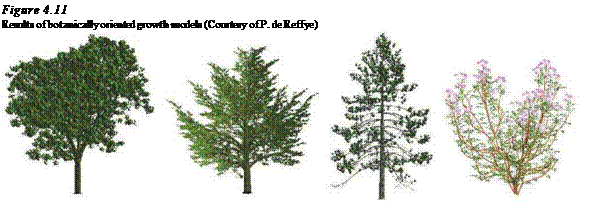 |
 |
An approach oriented on botanical growth rules was pioneered by De Reffye et al. [34]. The authors simulated the growth of the shoot axes in discrete time steps from node to node. one internode after the other is placed along a shoot, and branching and leaves are produced. The time steps are fixed within the branches of one order. Nevertheless, branches of higher order can grow with a greater speed than those with lower order.
Each bud carries several probabilities: the probability of dying, the probability of resting, and the probability to branching out. Again, we are here dealing
with a randomized controlled model, but this time with a much stronger sphere Section 4.8
of randomness, since wide-ranging structural characteristics can be modified. An Approach Based on Budding A similar approach with larger time steps was chosen by Remphrey et al. [173,
174] for the modeling and architectonic analysis of different plants.
Figure 4.10 illustrates the progression of the randomized controlled growth simulation by De Reffye et al. for two different sets of parameters. The x-marks designate the shoots that have already died off.
Thus, for the modeling of a tree, the following parameters must be specified: the age of the tree, the growth rate of the branches of different orders, the number of possible buds per node in relation to their order, and the probabilities of dying, resting, and branching. The pseudocode for the discrete simulation can be written as follows:
Algorithm 4.2:
Procedure budtree() begin
for each time step do begin
for each bud still living do begin
if bud does not die and does not rest then begin generate internode generate apical leaf end
for each applicable bud do begin
 |
if bud branches then generate branching end end end end
The models are available to the user in a library of plant algorithms. The commercially distributed product includes a large number of different species, which can be parameterized by using age and growth. other than the already mentioned botanical growth simulations, the method of De Reffye et al. enables simulation of anatomical correct growth, although the
|
|
|



